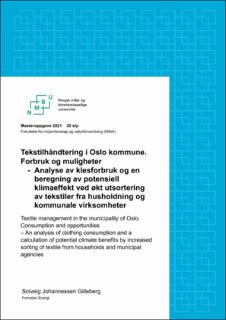| dc.contributor.advisor | Hanssen, Ole Jørgen | |
| dc.contributor.author | Gilleberg, Solveig Johannessen | |
| dc.coverage.spatial | Norway, Oslo | en_US |
| dc.date.accessioned | 2021-11-26T13:02:45Z | |
| dc.date.available | 2021-11-26T13:02:45Z | |
| dc.date.issued | 2021 | |
| dc.identifier.uri | https://hdl.handle.net/11250/2831689 | |
| dc.description.abstract | Dagens tekstilindustri forbruker store ressurser, noe som medfører store miljøpåvirkninger globalt. Frem til nylig har tekstiler som avfallsressurs, nesten ikke vært tema for myndighetene. Den europeiske union (EU) har uttalt at innen 2025 vil det komme krav om at alle kommuner skal ha egne ordninger for kildesortering av brukte tekstiler for sine innbyggere. Krav om implementering er fortsatt under utvikling. Hovedmålet er å skape løsninger for økt utnyttelse av tekstilfraksjonen. Utnyttelse av potensialet i brukte tekstiler vil bidra til oppnåelse av nasjonale mål, forpliktelser i Parisavtalen, FNs bærekraftsmål, EUs mål om 65% materialgjenvinning innen 2030 og Oslos eget mål om å bli en nullutslipps by innen 2030.
Studien av tekstilhåndtering gjelder Oslo kommune og er i hovedsak kvantitativ. Studien omfatter en analyse av hvilken mengde tekstilavfall som samles inn fra husholdninger og fra kommunal virksomhet i Oslo årlig. Kommunens klesforbruk blir analysert ved å studere innkjøpsdata fra kommunen. Videre blir potensiell klimaeffekt ved økt materialgjenvinning av tekstilavfall fra Oslos husholdninger og kommunale etater beregnet.
Formålet med denne studien har vært å kartlegge mengden tekstiler som avhendes fra husholdning og kommunale virksomheter i Oslo for 2019. Analyse av Oslo kommunes innkjøp av klær og estimering av klimaeffekt ved ulik håndtering av avhendende tekstiler er utført. I denne oppgaven er det estimert at rundt 7500 tonn husholdningstekstiler og 32 tonn klestekstiler fra Oslos kommunale virksomheter, går årlig til innsamling eller i restavfall. Husholdningstekstilene går til tekstilhåndtering, ved innsamling til ombruk og avfallshåndtering. Mens kommunale klær går direkte i restavfall. Estimatene indikerer helt tydelig at klimaeffekten for avfallshåndtering av tekstiler fra Oslo gir en økt klimanytte allerede i dag, men at potensialet er større, og særlig innen økt ombruk.
For å lykkes med et helhetlig system for tekstilhåndtering, må alle aktører som har en rolle i sirkulær økonomien, inkluderes. I utforming av løsning bør det vektlegges involvering av alle parter som sammen må sette tekstiler høyere på agendaen, gjennom et felles løft for tekstil. Ved kildesortering gir innbyggerne verdier tilbake til samfunnet, for ressurshøsting. God og entydig kommunikasjon opp imot innbyggerne er viktig for at innbyggerne skal forstå den viktige rollen de har som ressursgivere. Mulige tiltak for å nå dagens og fremtidige mål for materialgjenvinning og økt ombruk, blir også diskutert kort oppgaven. | en_US |
| dc.description.abstract | Today's textile industry consumes large resources which cause major negative environmental impacts globally. Until recently, textile as a waste resource has hardly been put in the spotlight. The European Union (EU) has stated that by 2025 there will be a requirement for all municipalities to have their own schemes for source sorting of used textiles in place for their inhabitants. The national implementing measures is still under development. The main goal is to create solutions for the utilization of the textile fraction. Exploitation of the potential in used textiles will contribute to national goals, obligations in the Paris Agreement, UN sustainability goals, the goal of 65% material recycling by 2030 and Oslo's own goal of becoming a zero emissions city by 2030.
In the study of this thesis, the focus is on Oslo, where it is analyzed; The amount of textile waste that is collected annually from households and municipal activities in Oslo municipality. Illustrate what the climate gain from extended material recycling of textile waste from Oslo could be and look at possible solutions to overcome barriers the industry faces to achieve current and future goals.
The results indicate, that there is a potential for climate gain through increased sorting for material recycling, and that reuse will contribute with further gains. Furthermore, my analysis show that the amount of textiles that end up in residual waste is still large. Roughly 50% of textile from households and close to 100% of textiles from Oslo's municipality activities end up in residual waste
To succeed with a comprehensive textile handling system, all actors with a seat around the circular economy "table" must be included. Secondly, the design of the solution should emphasize that all parties included, work to lift the textile fraction upwards in the waste hierarchy. And most importantly, unambiguous communication must be directed at the public, so that the resource providers understand their role in creating value through good source sorting and what they give back to society for value harvesting. Means to reach the goals of today and tomorrow, will also be discussed briefly. | en_US |
| dc.language.iso | nob | en_US |
| dc.rights | Navngivelse 4.0 Internasjonal | * |
| dc.rights | Navngivelse 4.0 Internasjonal | * |
| dc.rights.uri | http://creativecommons.org/licenses/by/4.0/deed.no | * |
| dc.subject | Klimaeffekter | en_US |
| dc.title | Tekstilhåndtering i Oslo kommune : forbruk og muligheter : analyse av klesforbruk og en beregning av potensiell klimaeffekt ved økt utsortering av tekstiler fra husholdninger og kommunale virksomheter | en_US |
| dc.title.alternative | Textile management in the municipality of Oslo : consumption and opportunities : an analysis of clothing consumption and a calculation of potential climate benefits by increased sorting of textile from households and municipal agencies | en_US |
| dc.type | Master thesis | en_US |
| dc.description.version | submittedVersion | en_US |
| dc.source.pagenumber | 90 | en_US |
| dc.description.localcode | M-FORNY | en_US |

